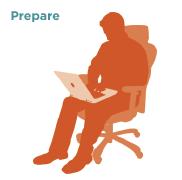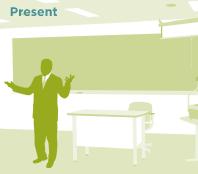|
|
Vol.
29 No. 4
July-August 2007
Speaking to the Public About Chemistry: A Three-Point Primer
by David A. Evans
At IUPAC’s 2005 General Assembly in Beijing, Peter Mahaffy, now chair of the Committee on Chemistry Education, and his team concluded that one of the definitive contributions that IUPAC could make to enhancing the public appreciation of chemistry would be to improve the communicationskills of chemists.
This article, in line with the Committee on Chemistry and Industry’s (COCI) remit, provides some simple tips and hints on public communication that might be of particular use to chemists in industry. Whereas the information has relevance to all sectors, it should be noted that many chemists in industry are called upon relatively rarely to speak to the public on chemical topics and many have little formal experience addressing audiences—in contradistinction, for example, to colleagues in academia. Much of the list is nothing but common sense, but some might find it useful for it to be collected in one place. However, it is recognized that this list cannot take the place of a training course featuring practical work.
The author has no claim to expertise in this topic. The material presented is the result of lessons learned in a lifetime of both receiving and giving some dreadful lectures. Here are some of the lecturers you might meet on the circuit:
- the Fugitive, who regards the lecture as torture and reads in terror from a shaking script with a faltering voice (we’ve all been there!)
- the Bombast, who loudly blasts the audience and browbeats them into submission with relentless personal logic
- the Thespian, who tries to impress with deep dramatic sincerity using hushed tones and anguished facial contortions
- the Columbo, who relates his/her work as a “whodunnit” detective story with the only worthwhile point revealed at the bitter end
- the Conceited, who irritatingly displays a confident air of clever self-satisfaction and regards the audience as another source of adulation
- the Bamboozler, who came along to show off an exquisite intellectual brilliance by purposely drowning the audience in complexity
- the Failure, who catharts all over the audience and details the serial difficulties and disappointments encountered
- the Techy, whose 3-D histogram slides resemble the Manhattan skyline and whose turn of phrase would honor Star Wars
Then there’s the Entertainer, the Mumbler, the Village Idiot . . . and then us!
The article assumes that a lecture presentation to the lay public has been requested. It is divided into three sections:
1. preparing for the lecture
2. presenting the lecture
3. follow up
 Preparing
for the Lecture Preparing
for the Lecture
This is the most important factor for ensuring a successful
presentation—and by far the most time-consuming. Success
or failure is dictated here.
- Understand your audience
- Find out from the organizer or an earlier speaker to the same audience the general level of knowledge of the attendees and pitch the lecture accordingly.
- Simplification of a topic for an audience is almost never regarded as patronizing—whereas talking above them is never forgiven.
- Get a description of the venue
- Ascertain the type of visual aids available and find out the dimensions of the lecture room. Size your visual aids accordingly.
- Be clear about audience expectations
- Provide the organizer with a brief synopsis of your intended talk (best done verbally) and again explain the level at which you intend to pitch it.
- Find out the expected duration of the talk and whether there will be time allotted for questions.
- Ask the organizer whether there are specific audience expectations (e.g., discussion of a current news topic or local event).
- Ascertain the requirements of the organizer(s)
- Establish whether you will be expected to submit a paper for publication, or to provide a written paper or summary.
- Ask if the press will be present (it is not uncommon for local reporters to attend public lectures) or shall you be required to attend a press briefing?
- Decide on the structure and key messages of the talk
- Choose a small number of key messages and state what they are.
- Be resolute in omitting favorite material that does not contribute to the key messages.
- Avoid audience overload by allowing some slack in timing—and never plan to run over!
- Prepare appropriate visual aids and any manuscripts required
- Use the most effective visual aid system available, but keep it simple. “Whiz Bang” for its own sake will distract from the messages.
- Make sure that slides are not too crowded—no more than six main bullet points per slide. Slides must be visible (all the words!) from the very back of the room—someone always sits there.
- Avoid having too many slides—a common mistake. If you need to rush, you will lose your audience; if you run over you will frustrate them and nobody will be listening to you.
- At all costs, avoid using complexity, either visual or written, to try to look clever. A speaker who purposely overwhelms an audience is foolish and is recognized as such by the audience.
- Practice makes perfect
- Dry-run your presentation with visual aids until the timing and content meet your approval.
- Be aware that many accomplished off-the-cuff speakers are dedicated to practice and training—but without killing spontaneity.
 Presenting
the Lecture Presenting
the Lecture
This objective takes relatively little time, but the memories,
good or bad, stay with you eternally. A little foresight pays
large dividends.
- Set up the lecture room
- Visit the lecture room well ahead of the arrival of the audience and familiarize yourself with the equipment and facilities.
- Load up and check your visual aids right through—many good lectures have been ruined by unexpected projector incompatibility or differences in PowerPoint versions.
-
You will be judged on the extent to which your material engages your audience as much as its
scientific merit. |
Brief the chair
- In order for you to be introduced by the chair, provide a brief CV and remember that nobody will be interested in your early school days!
- Inform the chair whether you will take questions during your talk or whether you would prefer these at the end–the latter is much preferred when addressing an unfamiliar audience.
- Ask the chair to give you a discreet five-minute warning prior to the end of your talk —and respect it!
- Stand and deliver—clearly, cogently, energetically, and to time
- If in doubt, ask the audience whether you can be heard at the back.
- Use written notes as an occasional prompt, but to read verbatim from a manuscript is normally unforgivable.
- Abbreviated prompts written on index cards are more effective than a highlighted manuscript, where it is too easy to get lost.
- Inexperienced speakers often rely on the security of having a complete manuscript against the possibility of “drying up.” This is acceptable provided the speaker returns to normality once the panic has passed.
- Your most visible attribute will be your perceived energy level—if you allow this to drop, the audience will follow you. Make sure you retain eye contact with all parts of your audience throughout.
- Engage your audience
- You will be judged on the extent to which your material engages your audience as much as its scientific merit.
- You can put your audience at ease at the outset with one or two informal comments or anecdotes which “humanize” yourself, but avoid convoluted jokes.
- Start by stating the messages that you intend to cover—and repeat them again as your conclusion. The messages should be reflected in your slide material.
- Use of the second person plural as in “You will know from your daily experiences . . .” or “In your medicine cabinet at home . . .” helps to make material more relevant to the audience and promotes engagement.
- Never fall into the temptation of promoting your favorite topic by unreasonably denigrating a competing scientific approach—the casualty will be science as a whole.
- It is unforgivable to attempt to demonstrate how smart you are by bamboozling your audience. Your job is to engage and to explain—not to try to impress.
- Remember that your audience attends your lecture to be both informed and entertained—in balanced amounts.
- Check your audience for understanding
- Direct questioning of the audience (“Is everybody with me?”); (“Am I going too fast?”) is unlikely to provide a truthful answer, given the milk of human kindness!
- Indirect questioning (“How many of you think that . . . ?”), (“Hands up those who believe that . . . ?”) is much more effective in both gauging understanding and keeping interest.
- Observation of all corners of the audience will provide clues, as will listening for audible clues (murmuring, shuffling, or even chattering).
- If you feel that you have lost the attention of your audience, slow down, re-energize, provide simpler explanations, and attempt to re-engage the listeners. Under no circumstances is it wise to speed up to get to the end faster. No one will be listening—you might as well sit down there and then.
- Entertain questions enthusiastically and sympathetically
- The key assumption has to be that no questions are off-limits unless the chair intervenes.
- Insist that questioners state their name and affiliation.
- Answers should be brief to allow everyone who wishes to participate.
- Avoid the temptation to use a question to re-start your lecture or to open up a new favorite topic.
- “I don’t know” is a better answer than indiscriminate waffle. You could offer to get back to the questioner once you have established an answer with an expert colleague.
- Thank your inquisitors for their questions, even if they are aggressive or negative. In the latter cases, it is better to politely restate your messages than to defend fiercely.
- Do not attempt to answer a question that is based upon emotion with relentless scientific logic. Rather, acknowledge the concern expressed and state what might be done to resolve the issue.
- It is permissible, in answering a question, to ask the questioner to comment on your answer. This provides another mechanism for engaging your audience.
 |
 Follow
Up Follow
Up
The relief experienced following successful completion of
a presentation can result in unintentional neglect of follow-up
actions. These are best tackled immediately following the
presentation:
- Deal with commitments to the organizers
- In addition to expressing thanks to the organizers, be sure to provide requested manuscripts—best done when the meeting is fresh in your mind.
- Fulfill promises to the audience
- Be sure to follow up any promises for materials, slides, or information made to members of the audience. Failure to do this can result in losing welcome converts to the chemical sciences.
- Review your lecture material
- It is likely that you will be asked to present a similar lecture in the future. It is a good idea to review and modify your material shortly after the lecture; you will be in a good position to judge what went well, and what did not!
Finally, it is important not to be discouraged by some hostility from your audience. It is unfortunate that many people have little understanding of science. Indeed, some regard it as chic to proudly pronounce their ignorance! Some will have emotional and irrational objections to “chemicals” per se. Although baseless, these can form a deeply held part of a person’s values. Just remember that “You cannot reason a person out of a position he did not reason himself into in the first place” (Jonathan Swift). However, human nature is such that almost everyone is on the lecturer’s side. They will wish you to do well, and are very forgiving of mistakes, even those that mortify the speaker under the scrutiny of a multitude of pairs of eyes. After all, a good and well-appreciated lecture is a win for both the audience and the speaker.
David A. Evans <[email protected]> is a member of the IUPAC Committee on Chemistry and Industry. A bio-organic chemist by training, Evans is retired as head of research and technology for Syngenta, AG.
Page last modified 10 July 2007.
Copyright © 2003-2007 International Union of Pure and Applied Chemistry.
Questions regarding the website, please contact [email protected] |